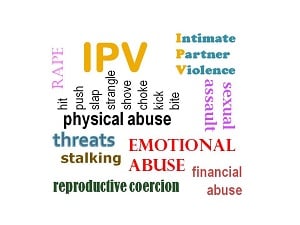Intimate Partner Violence – What Is It and What Does It Look Like?
Intimate Partner Violence – What Is It and What Does It Look Like?

Intimate partner violence (IPV) takes place in all settings, in all socioeconomic, religious, ethnic, and cultural groups. The overwhelming global burden of IPV is endured by women, and the most common perpetrators of violence against women are male intimate partners or ex-partners. However, women who are experiencing IPV often do not see themselves as abused.
IPV has long-lasting, serious effects on a woman’s physical and mental health. For example, a study found that women were up to ten times more likely to report depression and seventeen times more likely to report anxiety if they were in violent relationships. Because of this, it is important for women to understand what IPV looks like and what resources are available to someone experiencing IPV and looking for help.
Intimate Partner Violence (IPV) – What is it, and What Does it Look Like?
Sometimes called “domestic violence”, intimate partner violence (IPV) is a serious and widespread problem in which a current or former intimate partner engages in physical, sexual, verbal, or psychological violence or stalking (Breiding et al. 2015) .
Although most people associate IPV with physical harm, IPV can present itself in many different ways. For example, as opposed to the bruise or black eye that can mark physical abuse, emotional violence is a less talked-about form of IPV that leaves no physical scar. This form of abuse includes humiliation, insults, or criticism, and can be just as harmful as physical violence to one’s sense of self-worth. Similarly, psychological violence is another less observable example of IPV that involves intimidation, threats, and causing fear in one’s partner.
Sexual violence, another form of IPV, is far more common in relationships than people realize. Sexual violence can range from unwanted touching and sexual harassment to sexual assault or rape. Reproductive coercion is another type of sexual violence that many may not associate with IPV. This is when a partner tries to control the other’s reproductive choices, such as by banning their use of birth control.
Another less-known form of IPV is financial violence. This type takes the shape of financial control. A person may attempt to control their partner’s money or access to school or to their job. In doing so, the person can lead their partner to become completely dependent on them.
IPV is not always obvious, so it is important to be able to recognize its many faces.
Who Experiences IPV?
IPV does not discriminate. It can happen to anyone and in all settings, regardless of gender, class, socioeconomic status, religion, ethnicity, race or cultural groups. Whether dating, married, or living together, whether it’s a straight or same-sex relationship, IPV can occur in any relationship.
The overwhelming global burden of IPV is endured by women, and the most common perpetrators of violence against women are male intimate partners or ex-partners. However, women who are experiencing IPV often do not see themselves as abused.
In fact, IPV is actually more common than one may think. In the United States, intimate partner violence is widespread (National Coalition Against Domestic Violence, 2015):
- 1 in 3 women and 1 in 4 men have been physically abused by a partner in their lifetime.
- 1 in 7 women and 1 in 18 men have been stalked by their partner during their lifetime.
- IPV accounts for 15% of all violent crime.
- 1 in 5 women and 1 in 59 men in the United States have been raped in their lifetime. Almost half of these women and a third of these men were raped by an intimate partner.
- 1 in 15 children are exposed to IPV every year.
- Nearly 50% of women and men in the U.S. report psychological abuse by their partner (Black et al., 2011).
A Heavy Burden: The Consequences of IPV
The consequences of IPV can be profound and long-lasting. Victims of IPV may experience a variety of physical, psychological, and social problems, such as:
- Poor physical health;
- Depressed mood and/or anxiety;
- Trauma and posttraumatic stress disorder;
- Feelings of guilt or shame;
- Increased risk of substance abuse;
- Cardiac symptoms such as hypertension and chest pain;
- Chronic disorders and chronic pain;
- Gastrointestinal problems due to stress;
- Reproductive problems;
- Unsafe sexual behavior;
- Low self-esteem;
- Self-harm and suicide;
- Inability to trust others;
- Difficulty maintaining a job.
IPV has long-lasting, serious effects on a woman’s physical and mental health. For example, a study found that women were up to ten times more likely to report depression and seventeen times more likely to report anxiety if they were in violent relationships. Because of this, it is important for women to understand what IPV looks like and what resources are available to someone experiencing IPV and looking for help.
“That’s just how he/she is…” or Intimate Partner Violence?
Intimate partner violence may be visible, or it may be more subtle. When one is in the middle of relationship, it can sometimes be difficult to notice signs of aggression and violence.
However, there are certain clues that can help someone tell the difference between what a healthy and a toxic relationship looks like.
Signs to Watch Out For
Certain warning signs might help recognize if someone is experiencing IPV. When noticing the following behaviors in a partner, it may be time to take action:
- They use physical aggression. They often slap, hit, shove, or push their partner.
- They are unpredictable. Their moods tend to change rapidly and radically.
- They are often jealous, suspicious, and/or angry – even if they have no reason to be.
- They control their partner’s time. They monitor and control their partner’s activities, including whether they go to work or school, and how much they see their family and friends.
- They control their partner’s money. They make important financial decisions with shared money by themselves, or they take their partner’s money without permission.
- They use verbal threats. They are not afraid to name-call, swear, and yell at their partner.
- They isolate their partner. They may limit their partner’s use of the phone or other sources of communication, or may force their partner to stay at home.
- They minimize their partner’s feelings. They may also make their partner feel guilty or ashamed.
- They blame. They often try to blame their partner or others for their problems.
- They threaten – a lot. They may threaten to hurt themselves, their partner, or their partner’s loved ones if their partner tries to leave.
- They may force their partner to have sex – even if their partner does not want to.
Resources
Identifying and acknowledging the signs of IPV is the first step to ending it. IPV is never the victim’s fault, and there are many ways to find safety and support when someone finds themselves in this situation.
If someone is experiencing IPV, they are not alone. The resources below are great places to start reaching out for help or to receive guidance on where to go:
- If you or someone you know is in danger, call 911 immediately.
- National Domestic Violence Hotline – Call 1-800-799-7233 or TTY 1-800-787-3224 or use the secure online chat in English or Spanish here. This hotline offers support from well-trained, caring advocates to help victims and survivors of domestic violence to find support and assistance.
- ACF’s Family Violence Prevention and Services Program - The Family Violence Prevention and Services Program administers the Family Violence Prevention and Services Act (FVPSA), the primary federal funding stream dedicated to the support of emergency shelter and related assistance for victims of domestic violence and their children.
- National Coalition Against Domestic Violence: State Coalition List - A directory of state offices that can help you find local support, shelter, and free or low-cost legal services. Includes all U.S. states, as well as the District of Columbia, Puerto Rico, and the Virgin Islands.












